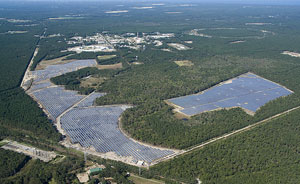Long Island, New York is about to get 100 megawatts (MW) more of solar, thanks to the feed-in tariff (FiT) put in place last year, and New York State could get 2.2 gigawatts (GW) over the next decade.
Only a dozen or so US jurisdictions have a feed-in tariff, but they are always successful because they offer attractive returns for solar electricity.
By the end of this year, LIPA plans to announce feed-in tariffs for 20 MW of wind, fuel cells and other renewable resources, and a Request for Proposals for up to 280 MW of renewable energy.
The Long Island Power Authority (LIPA) "CLEAN Solar Initiative," will feed another 13,000 homes with solar with this addition of locally-sourced electricity. The first phase of the program, which incentivizes medium-sized solar systems, was capped at 50 MW.
Solar installations in designated areas will be awarded via a bidding process. They want solar sited on what’s known as the South Fork (where the Hampton’s and Montauk are located) to reduce the load where energy delivery is constrained. That will help defer, reduce or eliminate hundreds of millions of dollars of investments to build new generation plants and transmission lines, LIPA says.
Long Island’s biggest solar plant, near Brookhaven National Lab:

"The expansion of Clean Solar Initiative is yet another signal that clean local energy benefits both consumers and utilities," says Craig Lewis, executive director of the Clean Coalition. "Furthermore, LIPA’s recognition that distributed solar provides at least 7 cents per kilowatt-hour in avoided transmission and central generation costs makes clear to the rest of the country that the locational value of wholesale distributed generation is undeniable and significant."
The Clean Solar Initiative-II features:
- Price competition rather than a pre-determined fixed price
- Geographically targeted to benefit constrained areas
- Eligible projects are between 100 kilowatts to 2 MW
Last year, a study concluded that Long Island can get 100% of its electricity from renewables by 2030 and can fulfill residential demand by 2020. Typical utility bills would rise $12-$18 a monthly – the cost of a pizza.
Aggressive energy efficiency efforts, large scale wind, solar and other renewables would replace old, inefficient fossil-fuel power plants. Some fossil fuel backup would be needed; emissions would be offset by purchasing renewable energy credits.
New York State Passes Legislation
Meanwhile on the state level, legislation passed that could bring 2.2 GW of solar to New York over the next 10 years.
It expands the NY-Sun Solar Jobs program by $150 million a year for the next 10 years, which will expand solar systems for homes and businesses, give certainty to the solar industry and create jobs. The program began in 2011 and the goal is to install four times the amount in 2013.
Governor Cuomo proposed the expansion (New York Solar Bill) after the devastation caused by Hurricane Sandy made it clear the state’s infrastructure is in dire need of upgrades to increase resiliency to extreme weather caused by climate change.
Unfortunately, it passed without the time to reconcile the bill between the Senate and Assembly, but it’s expected to pass in the next session.
Last month, the New York Public Service Commission approved increasing the net metering cap for all five utilities, which could bring in another 462 MW.
Currently, New York ranks 10th among states for solar capacity with just 60 MW.
Learn more about Long Island’s FiT:
